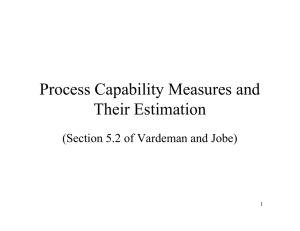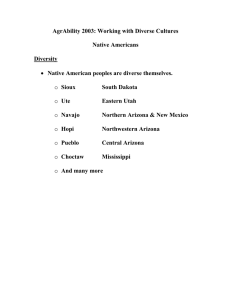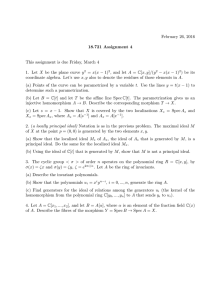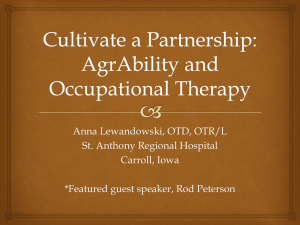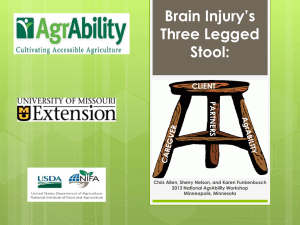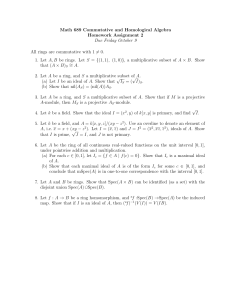Overview PowerPoint
advertisement
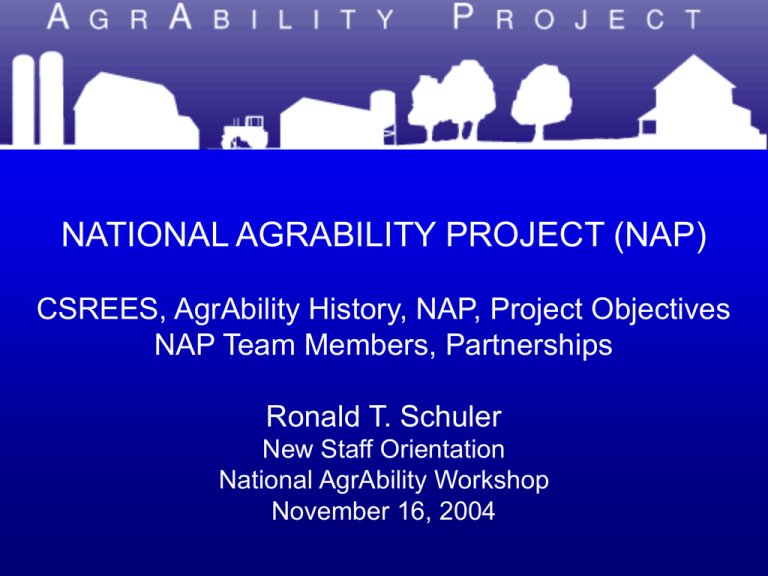
NATIONAL AGRABILITY PROJECT NATIONAL AGRABILITY PROJECT (NAP) CSREES, AgrAbility History, NAP, Project Objectives NAP Team Members, Partnerships Ronald T. Schuler New Staff Orientation National AgrAbility Workshop November 16, 2004 Outline CSREES – what is CSREES and why it important (Ivan Graf) AgrAbility History – when and how did AgrAbility start Project Objectives -what are they and why are they important Staff Members and Their Responsibilities- who do you call or e-mail when you have questions Partnerships - principles to insure a successful state team A Brief History of AgrAbility • Arose from a grass roots effort championed by Easter Seals • Easter Seals shopped the concept to several federal departments before selecting USDA • Modeled after pioneering efforts in Iowa (Easter Seals) and Vermont (University) • Grown from 8 awards in 1991 to 24 awards totaling about $4.0 M in 2004 What Does CSREES Do? • Program leadership to identify, develop, and manage programs to support university-based and other institutional research, education, and extension. – Connect projects and government – Collect data to justify creating programs • Fair, effective, and efficient administration of Federal assistance implementing research, education, and extension awards and agreements. – Aim to satisfy both Legislative and Executive Branches – Collect data to justify continuing programs More About CSREES . . . • Staff of about 360 USDA employees and about 30 contractors • Managed $1.13 B in appropriations in FY 2004 • Extension appropriations totaled approximately $454 M in FY 2004 • Includes formula, special grants, and competitive grant programs What is the Cooperative Extension System (CES)? • Partnership of : – 3,000 counties with over 9,000 local educators – Land-Grant Institutions • Fifty-six 1862 Institutions • Eighteen historically black 1890 Institutions • Thirty-one Native American 1994 Institutions – USDA- Cooperative State Research, Education, and Extension Service (CSREES) CES MISSION The Cooperative Extension System helps people improve their lives and communities through an educational process that uses scientific knowledge focused on issues critical to the economic, agricultural, societal, health/safety, and environmental progress of all Americans. How does AgrAbility Relate to Coop. Extension’s Mission? ??? • “Helps people improve their lives. . .” – Focuses on needs of persons with disabilities employed in agriculture • “Through an educational process. . .” – Assist persons with disabilities become more active in their farming lifestyle – Teach service providers who routinely interact with persons with disabilities • “. . . That uses scientific knowledge . . .” – Ergonomics, electronics, mechanics, etc. What Does CSREES Do for AgrAbility Projects? Promotes, assists and helps • Promotes your accomplishments across the USDA and the university system • Assists during project transitions • Helps projects make choices based on the agency’s administrative requirements and Congress’ mandate to the program What is the Farm Bill and Why is It Important to AgrAbility? • Farm Bills have: – Authorized partnership between land-grant’s and non-profit disability organizations – Established funding recommendations – Provided guidance on eligible programs • Farm Bills include: – FACT (1990); FAIR (1996) – AREERA (1998); FSRIA (2002) • Appropriations provide for AgrAbility under Smith-Lever 3(d), Farm Safety Funds FACT 1990: Program Objectives: • • • • • Provide education and assistance to accommodate disability in farming Educate service providers who support AgrAbility clients Provide on-farm technical advice Involve others in early identification Mobilize volunteer resources Farm Bill Provisions - Continued • FACT (1990) – Maximum Award Amount = $150,000 – National Project to provide technical assistance, training, and information dissemination to support local projects – Program authorized for 1991-1996 • FAIR (1996) – Extends program to 1997 • AREERA (1998) – Extends program to 2002 – Limits National Project grant to 15% of program appropriation • FSRIA (2002) – Extends program to 2007 – Requests that new applicants receive full consideration AgrAbility Funds Do Support: (Objectives for new four year plans for projects starting in 2005) • Education - AgrAbility’s long-term investment strategy – Focuses on accommodating disabilities and avoiding secondary injuries – Directed to health, farm, and government service providers • Networking - Depends on education and will eventually make AgrAbility sustainable – Encourages the sharing of information among, and the provision of services, value, and/or funds from individuals or organizations not employed by AgrAbility – Includes customers, peer supporters, volunteer groups, university student groups, stakeholders and public and private funding organizations AgrAbility Funds Do Support: • Assistance - Satisfies customers’ immediate needs inadequately addressed by health, farm, and government service providers. – Focuses on individualized consultative services that increase the likelihood that AgrAbility Project customers and their farm operations experience success – Involves AgrAbility customers and others working at the same farms • Marketing - Makes key audiences aware of AgrAbility and its initiatives. – Concentrates on awareness to the exclusion of information required to provide education, assistance, or facilitate networking – Includes everyone AgrAbility Funds May Not: • Pay for assistive technology or farm site modifications • Use federal funds to solicit other federal funds • Pay tuition or student fees • Pay overhead or indirect costs • Conduct research (work must remain within accepted bounds of Extension) New Staff Points to Remember • CSREES General Terms and Conditions found in FY2005 Request for Applications – http://www.csrees.usda.gov/funding/rfas/05_agrab ility.html • Projects must re-apply every year – Letter to PI’s from Brad Rein dated October 6, 2004 • Use the National AgrAbility Project for: – – – – Expertise Training Data collection and analysis Information dissemination New Staff Points to Remember • Keep your directors, colleagues, and CSREES informed of any significant recognition your project receives • Inform me if you have a change in or reorganization of project staff • Partner even on report writing and submit them on time CSREES Key Staff Vacant - Program Specialist Brad Rein – National Program Supervisor – 202-401-0151 – brein@csrees.usda.gov Kim Knoblock – Admin. Support – 202-401-4587 – kknoblock@csrees.usda.gov National AgrAbility Project A Partnership Between Easter Seals and University of Wisconsin-Extension National AgrAbility Organizational Chart USDA-CSREES* Brad Rein, National Program Leader Vacant, Program Specialist Ron Schuler(UW) Project Leader Cheryl Skjolaas(UW) Project Manager Therese Willkomm Assistive Tech. Spec. Mark Novak(UW) Agr. Technologist Doug Carmon(ES) Project Director Deborah Danuser(ES) Market & Com. Spec. Mary Beck(UW) Rehabilitation Spec. Leah Nell Adams(UW) Evaluation Spec. Sherry Liantonio(UW) Program Assistant * CSREES-Cooperative States Research, Education and Extension Service National AgrAbility Organizational Chart USDA-CSREES* Brad Rein, National Program Leader Vacant, Program Specialist Ron Schuler(UW) Project Leader Cheryl Skjolaas(UW) Project Manager Therese Willkomm Assistive Tech. Spec. Mark Novak(UW) Agr. Technologist Mary Beck(UW) Rehabilitation Spec. Leah Nell Adams(UW) Evaluation Spec. Sherry Liantonio(UW) Program Assistant Doug Carmon(ES) Project Director Deborah Danuser(ES) Market & Com. Spec. USDA-CSREES Responsibilities: Administer the Program Specific responsibilities Direct the request for proposals Oversee review process Insure funded projects follow rules * CSREES-Cooperative States Research, Education and Extension Service National AgrAbility Organizational Chart USDA-CSREES* Brad Rein, National Program Leader Vacant, Program Specialist Ron Schuler(UW) Project Leader Cheryl Skjolaas(UW) Project Manager Therese Willkomm Assistive Tech. Spec. Mark Novak(UW) Agr. Technologist Mary Beck(UW) Rehabilitation Spec. Leah Nell Adams(UW) Evaluation Spec. Sherry Liantonio(UW) Program Assistant Doug Carmon(ES) Project Director Deborah Danuser(ES) Market & Com. Spec. Project Leader Responsibilities: Provides Overall management and reporting activities of the project National AgrAbility Organizational Chart USDA-CSREES* Brad Rein, National Program Leader Vacant, Program Specialist Ron Schuler(UW) Project Leader Cheryl Skjolaas(UW) Project Manager Therese Willkomm Assistive Tech. Spec. Mark Novak(UW) Agr. Technologist Mary Beck(UW) Rehabilitation Spec. Leah Nell Adams(UW) Evaluation Spec. Sherry Liantonio(UW) Program Assistant Doug Carmon(ES) Project Director Deborah Danuser(ES) Market & Com. Spec. Project Manager Responsibilities: Coordinates National Training Workshop, area training and new staff orientation Supervises technical assistance and information dissemination Directs the preparation of the annual and final reports National AgrAbility Organizational Chart USDA-CSREES* Brad Rein, National Program Leader Vacant, Program Specialist Ron Schuler(UW) Project Leader Cheryl Skjolaas(UW) Project Manager Therese Willkomm Assistive Tech. Spec. Mark Novak(UW) Agr. Technologist Mary Beck(UW) Rehabilitation Spec. Leah Nell Adams(UW) Evaluation Spec. Sherry Liantonio(UW) Program Assistant Doug Carmon(ES) Project Director Deborah Danuser(ES) Market & Com. Spec. Assistive Tech. Specialist Responsibilities: Provide technical support on assistive technology with a special focus on secondary injuries National AgrAbility Organizational Chart USDA-CSREES* Brad Rein, National Program Leader Vacant, Program Specialist Ron Schuler(UW) Project Leader Cheryl Skjolaas(UW) Project Manager Therese Willkomm Assistive Tech. Spec. Mark Novak(UW) Agr. Technologist Mary Beck(UW) Rehabilitation Spec. Leah Nell Adams(UW) Evaluation Spec. Sherry Liantonio(UW) Program Assistant Doug Carmon(ES) Project Director Deborah Danuser(ES) Market & Com. Spec. ES Project Director Responsibilities: Provide leadership for ES partner Coordinate education for frontline rehabilitation and healthcare professionals and networking for volunteer program National AgrAbility Organizational Chart USDA-CSREES* Brad Rein, National Program Leader Vacant, Program Specialist Ron Schuler(UW) Project Leader Cheryl Skjolaas(UW) Project Manager Therese Willkomm Assistive Tech. Spec. Mark Novak(UW) Agr. Technologist Mary Beck(UW) Rehabilitation Spec. Leah Nell Adams(UW) Evaluation Spec. Sherry Liantonio(UW) Program Assistant Doug Carmon(ES) Project Director Deborah Danuser(ES) Market & Com. Spec. Agr. Technologist Responsibilities: Provide training and technical assistance on agricultural machinery, quipment, and buildings with assistive technology Manage web site National AgrAbility Organizational Chart USDA-CSREES* Brad Rein, National Program Leader Vacant, Program Specialist Ron Schuler(UW) Project Leader Cheryl Skjolaas(UW) Project Manager Therese Willkomm Assistive Tech. Spec. Mark Novak(UW) Agr. Technologist Mary Beck(UW) Rehabilitation Spec. Leah Nell Adams(UW) Evaluation Spec. Sherry Liantonio(UW) Program Assistant Doug Carmon(ES) Project Director Deborah Danuser(ES) Market & Com. Spec. Rehabilitation Spec. Responsibilities: Provides training and technical assistance with respect to: assistive technology government programs other rehabilitation issues cultural diversity National AgrAbility Organizational Chart USDA-CSREES* Brad Rein, National Program Leader Vacant, Program Specialist Ron Schuler(UW) Project Leader Cheryl Skjolaas(UW) Project Manager Therese Willkomm Assistive Tech. Spec. Mark Novak(UW) Agr. Technologist Doug Carmon(ES) Project Director Deborah Danuser(ES) Market & Com. Spec. Mary Beck(UW) Rehabilitation Spec. Leah Nell Adams(UW) Evaluation Spec. Sherry Liantonio(UW) Program Assistant Evaluation Specialist Responsibility: Directs the evaluation activities of the program National AgrAbility Organizational Chart USDA-CSREES* Brad Rein, National Program Leader Vacant, Program Specialist Ron Schuler(UW) Project Leader Cheryl Skjolaas(UW) Project Manager Therese Willkomm Assistive Tech. Spec. Mark Novak(UW) Agr. Technologist Doug Carmon(ES) Project Director Deborah Danuser(ES) Market & Com. Spec. Mary Beck(UW) Rehabilitation Spec. Leah Nell Adams(UW) Evaluation Spec. Sherry Liantonio(UW) Program Assistant Program Assistant Responsibilities: Provide clerical support and word proc. Answer toll free phone-serve as receptionist Complete data entry and desktop publishing Manage mailings Maintain Cooperative Extension files National AgrAbility Organizational Chart USDA-CSREES* Brad Rein, National Program Leader Vacant, Program Specialist Ron Schuler(UW) Project Leader Cheryl Skjolaas(UW) Project Manager Therese Willkomm Assistive Tech. Spec. Mark Novak(UW) Agr. Technologist Mary Beck(UW) Rehabilitation Spec. Leah Nell Adams(UW) Evaluation Spec. Sherry Liantonio(UW) Program Assistant Doug Carmon(ES) Project Director Deborah Danuser(ES) Market. & Com. Spec. Marketing and Communication Specialist Responsibilities: Responds to information requests Disseminates project-related info. to staff Coordinates the marketing plan Produce Monthly Newsletter and Quarterly Principles of Partnership •Help state project staff excel •Provide high quality, outcome oriented training, tech. assist. and information dissemination •Leverage opportunities and promote innovation •Lead and promote AgrAbility goals •Provide full access to all information and resources •Build capacity of state project staff Final Point-Partner Treat your partner the way you would like them to treat you Concluding remarks • • • • CSREES National Project Objectives Staff Member and Their Responsibilities Principles of Partnership THE END
